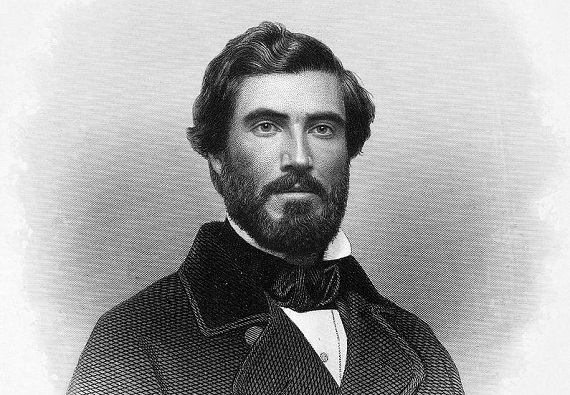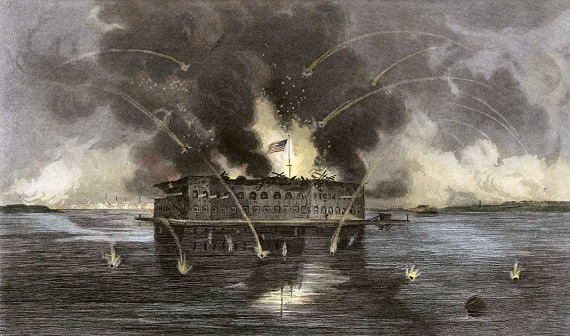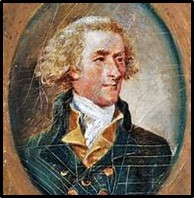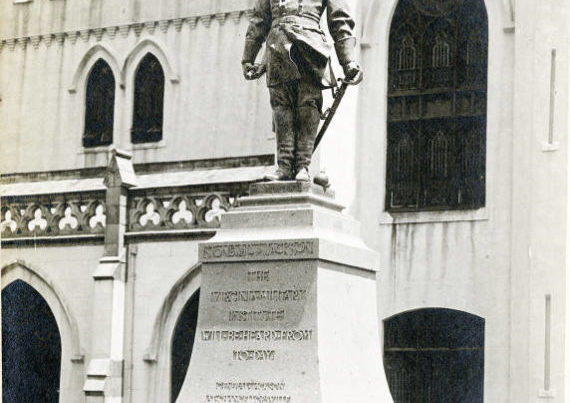Harriet Beecher Stowe’s 1851 phantasmagorical image of slave life in the South has long been regarded as one of the sparks that ignited the War Between the States. However, a now almost forgotten anti-slavery polemic by the North Carolina abolitionist Hinton Rowan Helper did far more to inflame the nation at that time than did “Uncle Tom’s Cabin.” In fact, Helper even poked fun at Stowe’s work in the preface of his book “The Impending Crisis of the South : How to Meet It” when he quipped that while “Yankee wives have written the most popular fictions of slavery, men should give the facts.” In its day, Helper’s book was also effectively employed by the Free-Soil Republicans as a propaganda piece in Lincoln’s 1860 presidential campaign.
Helper’s book was penned in Baltimore but no Maryland publisher would print it, deeming the work to be little more than an illegal clarion call for slave insurrections in the South. After its publication in New York in 1857, sale of the book was also banned throughout all the Southern States. Unlike the writings of Stowe and other Northern abolitionists, Helper’s attack on slavery was not a moralistic one that dwelt on the evils of the system itself or even an attempt to instill any feeling of compassion for the black Africans involved, but rather an effort to raise the level of the South’s economy by empowering its white, generally non-slaveholding middle-class farmers and businessmen. Helper felt that if black slavery were abolished it would bring to an end what he termed the “villainous oligarchy” of the Southern planters and allow the agrarian South to better compete with the more industrialized North.
A major portion of the book was filled with various charts, tables and detailed comparisons between the North and South in 1850 on a state-by-state basis. This material covered a broad variety of items, from very specific agricultural and industrial production to population figures, land ownership, banking statistics, imports and exports, railroad mileage, educational facilities, levels of literacy and even church attendance. Helper’s contention was that the great disparity between the two regions was caused by the use of slave rather than free labor, and that the North was making pawns of the slaveholding Southern planters by using their venality to help the North maintain its advantage. He charged that the plantation owners, who he termed “chevaliers of the lash” who spend their days “lolling in their piazzas” were an oligarchy that suppressed the South’s cultural and industrial evolution and that slavery was the key to their domination. While Helper did not oppose slavery on moral grounds and even ridiculed the idea that the Bible sanctioned the institution, he argued that the use of slave labor was the primary cause in holding back the South’s economic growth.
A full chapter was also devoted to anti-slavery statements made by numerous American leaders, starting with the Founding Fathers from the South. Helper first gave a number of quotes from letters written by George Washington in which the first president spoke out against slavery and his hope that some plan might be devised to abolish the institution. Also cited was Washington’s last will and testament in which he requested that upon the death of his wife “that all the slaves which I hold in my own right shall receive their freedom.” Helper then quoted statements made by Thomas Jefferson, such as “the abolition of slavery is the greatest desire in these Colonies, where it was unhappily introduced in their infancy.” Others who were cited at length were James Madison, James Monroe, Patrick Henry, Henry Clay and many other leading figures from each of the Southern States, as well as a plethora of anti-slavery statements that had appeared in a number of Southern publications.
Another theme of Helper’s book was his dream of creating mighty commercial and industrial cities in the South at ports in such areas as the Carolinas, Georgia and Virginia. He also thought that fleets of commercial shipping should be constructed at such points which could be used to carry goods to and from the South rather than rely on Northern and European shipping interests. He stated that until these facilities were established at such metropolises, the South could never properly develop its commercial resources, nor hope to rival the North or attain an eminent position in the world. Helper further estimated that the South’s commercial and industrial deficiency was costing the region as much as a hundred twenty million dollars annually. He also felt that the creation of large urban areas would increase the South’s prestige and add to its wealth by attracting more foreign trade and tourism. Here Helper again charged that the oligarchy of slavery was to blame for preventing the building of such centers and that the slaveholders, who he called the “avaricious assassinators” of the the South, were allowing the South’s wealth to be transported to the North.
Perhaps the weakest portion of Helper’s book, however, was the section in which he presented his ideas on how slavery, which he termed “the frightful tumor on the body politic,” could be eliminated. Basically it was a highly unlikely and unrealistic call for non-slaveholding white Southerners to band together and merely avoid all contact with slave owner. This would also include not patronizing any establishment that employed slave labor, as well as not voting for any pro-slavery candidates or subscribing to any pro-slavery publications. The final part of Helper’s plan was an equally unworkable slaveholder tax of sixty dollars per slave to pay for their transportation to Liberia, Central or South America, or any other, as Helper put it, “comfortable settlement within the boundaries of the United States.” The plan also outlined an additional tax of forty dollars per slave to be paid directly to all those freed . . . the first actual call for the slavery reparations that are so prominent in today’s political agenda. Of course Helper presented no plan as to who would collect such taxes or who would be responsible for making the transportation and reparation payments.
As few, if any, in the South ever had a chance to read his book, Helper’s dream that his fellow Southerners would rise up en masse and embrace his policies was merely a figment of his overwrought imagination. Even if they had read it, the reality of slavery presented insuperable problems that Helper never bothered to address. First and foremost was the reality of restitution, as all slaveholders large and small had a great deal of capital invested in their slaves and would suffer a devastating financial loss should all the slaves be suddenly freed, as well as having to pay a heavy additional tax for such freedom. The second problem was who would do the slave’s work, particularly as the former slaveholders would have little cash available to pay free white workers. Furthermore, as the primary cash crops of the South at that time, cotton, sugar and tobacco, were all completely labor intensive, finding the necessary labor force would have been a virtual impossibility.
While he made no mention of it in his book, perhaps Helper had also dreamt of an industrialized and mechanized South that would replace slave labor. It is certainly possible that he had heard of Samuel Rembert and Jedidiah Prescott in Memphis, Tennessee, who had patented a horse-drawn cotton harvester in 1850, but he would also have known that their machine had soon proven to be impractical. It was not until over eighty years later that another Memphis inventor, John Rust, would devise a truly workable harvester to replace the hand picking of cotton, and even then full production of such a device by International Harvester did not take place until 1947 due to the exigencies of the Second World War. As to the other major Southern crops of Helper’s day, while another animal-driven device for cutting sugarcane had been devised in the early Nineteenth Century, it was not until 1953 that Joseph Pugh of Louisiana patented a truly serviceable sugarcane harvester. The mechanized harvesting of tobacco came even a bit later when Gilbert Alphin of Kenansville, North Carolina, patented the first such machine in 1955.
Just as Helper’s book failed to reach its intended audience in the South, his entire life was one of failed efforts . . . ending in madness, poverty and suicide at age seventy-nine. Helper was born to a slaveholding farm family in Mocksville, North Carolina, on December 27, 1829. After graduating from the Mocksville Academy in 1848, he traveled west to seek his fortune in the California goldfields but found nothing there but five years of failure that led him to write a book entitled “California Land of Gold : Reality vs. Fiction” in which he vilified the new State . . . calling it the “false El Dorado.”
Soon after his return to North Carolina in 1855, Helper moved to Baltimore where he wrote his anti-slavery book. When war broke out, he appealed to the Republicans for assistance and was appointed by President Lincoln as the U. S. consul in Buenos Aires. Helper spent the war years in Argentina where he married Maria Louisa Rodriquez and in 1867 the couple returned to the United States. They went first to Asheville in North Carolina but soon found that he was unwelcome there and went to Saint Louis, Missouri, where they lived for over ten years. They then moved to Washington, D. C. where, after they had their only child, his wife became blind and returned to Argentina with their son. Helper then spent most of his remaining years and finances in a futile effort to promote a railroad that would run from Hudson’s Bay in northern Canada to Tierra del Fuego at the southern tip of Argentine.
During his later years, Helper turned much of his frustration into a personal vendetta against the nation’s black population and became a rabid racist, even to the point of refusing to patronize any establishment that employed black workers. He also wrote a trilogy of violently anti-black books from 1867 to 1871, “Nojoque, a Question for a Continent” in which, like the Nazis a half century later, he advocated not only driving a whole group of people out of the country, but ending their entire existence. The book called a black person “a thing of ugliness, disease, and death,” and a “most hateable [sic] thing.” Helper’s next two books, “The Negroes in Negroland; The Negroes in America; And Negroes Generally” and ”Noonday Exigencies in America” continued his bitter and vitriolic vilification of the black race and the advocation of its total expulsion from the United States.
Alone, penniless and completely broken both physically and mentally, Helper finally ended his misery in March of 1909 by turning on the gas in his squalid Washington apartment. Helper is now an all but forgotten would-be Southern hero whose irrepressible desire was to, in his words, “do something to elevate the South to an honorable and powerful position among the enlightened quarters of the globe,” While his dreams were never realized, his 1857 book did do much to write the final chapter on slavery in America.







